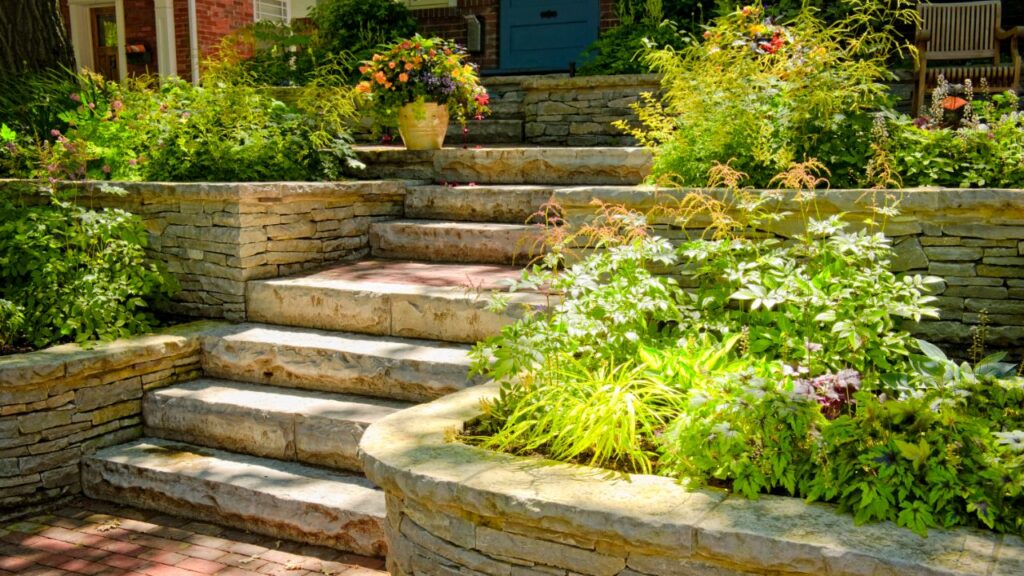As its name suggests, retaining walls help keep any material from sliding or eroding. This is the most generalized version of what a retaining wall is. More specifically, retaining walls are strong, rigid, and often used in mountainous areas. These walls help control downhill erosion and sliding of soil.
Retaining walls laterally support the soil so that it cannot follow its natural path down the slopes. By keeping all the land restrained and restricted, these walls allow your property to look clean and functional.
The walls are crucial for properties located on sloped lands because soil can fall into your homes or slide from below your house or property. Soil sliding in homes can hurt anyone and may cause the entire structure to slide and collapse in moments. Retaining walls are used to prevent something like this from happening.
Benefits of a Retaining Wall for Your Landscape Design
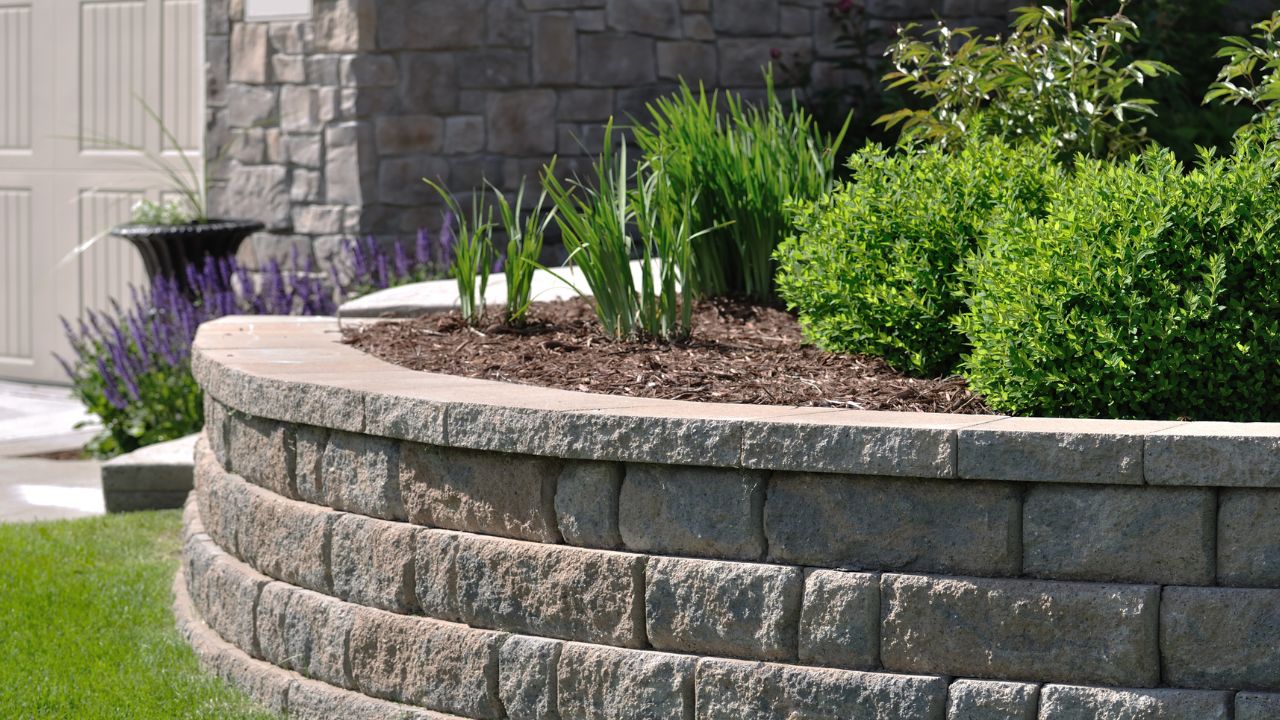
For all styles of landscapes, a well-planned retaining wall can be the defining feature that your backyard needs! Other than its primary function of providing support in keeping the soil from eroding, retaining walls have a lot of other benefits that can help enhance landscape design.
Structural Support
As mentioned above, providing structure is the primary function of retaining walls. Specifically for landscapes featuring small hills and slopes, retaining walls help prevent landslides. It ensures the well-being of the house and helps reduce the danger of severe damage.
Preventing Soil Erosion and Providing Flood Control
For landscapes that do not have a lot of trees, retaining walls help hold the soil in place, which can slide due to wind, water, or any other natural reason. A well-placed retaining wall helps reduce the gradient of a landscape, which helps reduce erosion and the flow or speed of water in case of flooding caused by heavy rainfall.
Integrating drainage pipes in the structure of retaining walls can help in effective flood control. It allows for better drainage and water control so that flood water is more likely to soak in the soil than slide off the surface.
Additional Functional Space for Your Yard
Landscapes with hills and mounds are beautiful but take up too much space. Retaining walls add functional space to your backyard, which can be used to showcase planting, gardens, and even patios. Their presence may seem imposing, but they add structure to the landscape.
Aesthetics
Depending on their height and the material used to build them, retaining walls can be seen as a bold and attractive feature within your backyard. The contrast created by using a concrete or stone retaining wall against the natural, lush landscape creates a naturally elegant look. If a retaining wall is utilized smartly, with the correct height and material, it can act as a seating wall. The different variety of materials available for retaining walls allows them to fit all styles of landscapes and designs, so they can naturally fit with the existing aesthetic of your house.
Factors to Consider Before Choosing a Retaining Wall
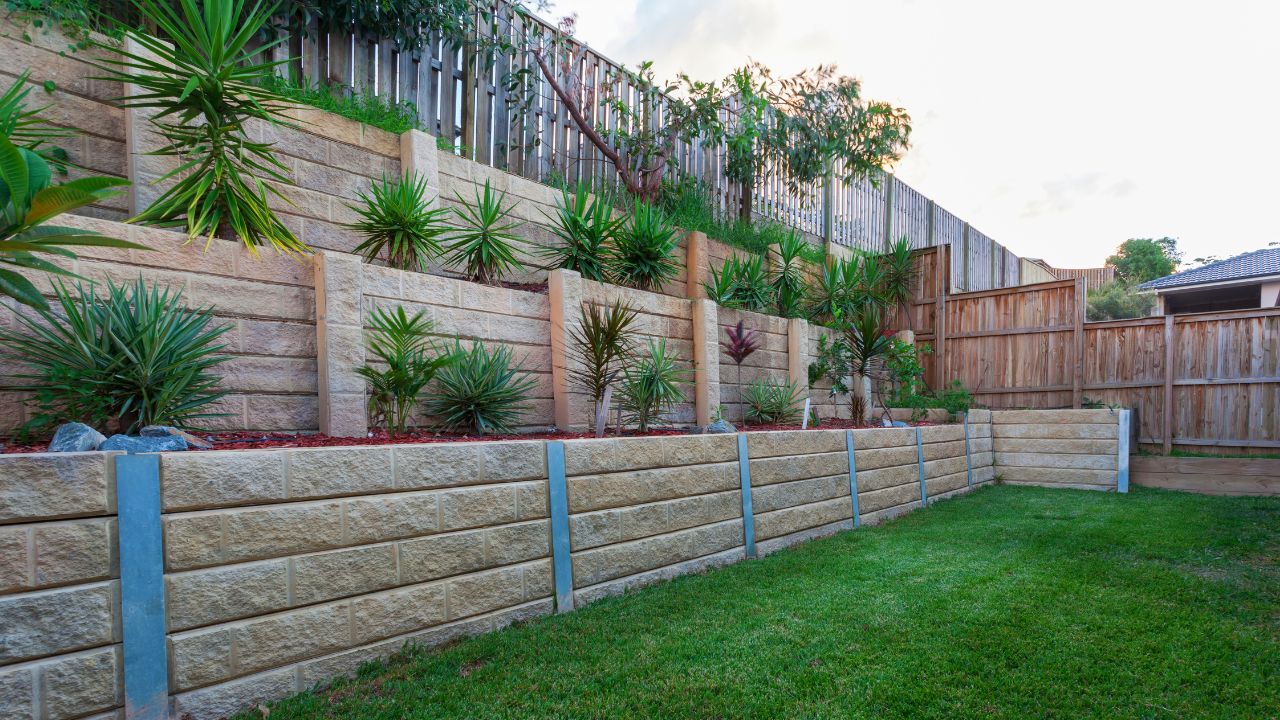
When choosing a retaining wall to fit your landscape, you need to consider many factors before making a final decision. Without first delving into the specifics, here are a few generalized questions you need to ask yourself before you invest in a retaining wall for your landscape.
What Materials to Choose From?
Selecting the best types of material that suit your needs is the most important factor in achieving a naturally flowing retaining wall aesthetic. There is a huge range of materials to choose from. Due to the work a retaining wall does, no matter your aesthetic, the material you choose must be long-lasting. Some durable materials for retaining walls are flagstone rock, concrete, timber, brick veneer, vertical poles, etc.
What Should be the Placement?
Pre-planning the onsite placement of your retaining wall helps avoid the extra expense of redoing or relocating the wall if something goes wrong because relocating an installed wall can be a huge task. It is better and cheaper to do your research and be satisfied with your choice.
How to Accommodate the Drainage?
If there is no proper drainage for retaining walls, the build-up of water and moisture from the soil can weaken the wall foundations, which may cause them to collapse. Therefore, consider installing some sort of drainage system so that water does not build up at the back of the wall. This can usually be achieved using manufactured drainage blankets, drain pipes, or gravel backfill. The issue of drainage can also be solved by making a “weep hole” to allow water to drain from behind the wall.
How to Build a Sturdy Foundation?
A wall is nothing without a sturdy foundation and for a wall structure that is bound to come into contact with a lot of moisture and has the job of bearing pressure (from the soil), sturdy and strong foundations are essential. Building retaining walls from structurally sound, compound foundation sub-base material or level, and compacted earth or gravel fill is important. The sizing of the foundation matters a lot as well, where it typically should extend one foot beyond (front and back) the width of the wall.
How to Ensure Wall Security?
The position of the walls can help make it more stable, such as sloping it back or making it “lay back” into the retained slope.
How Much Does it Cost to Install a Retaining Wall?
The standard and average cost of installing retaining walls can range from $2o to $35 per square foot of the wall. The cost is bound to vary depending on the materials used and the height of the wall. There is a tremendous difference in the cost of structural walls and dry-laid walls, where structural walls can cost up to 10 times more. If you’re looking for a retaining wall design calculator to estimate your project costs more accurately, you can find one here.
Wall Types And Design Ideas:
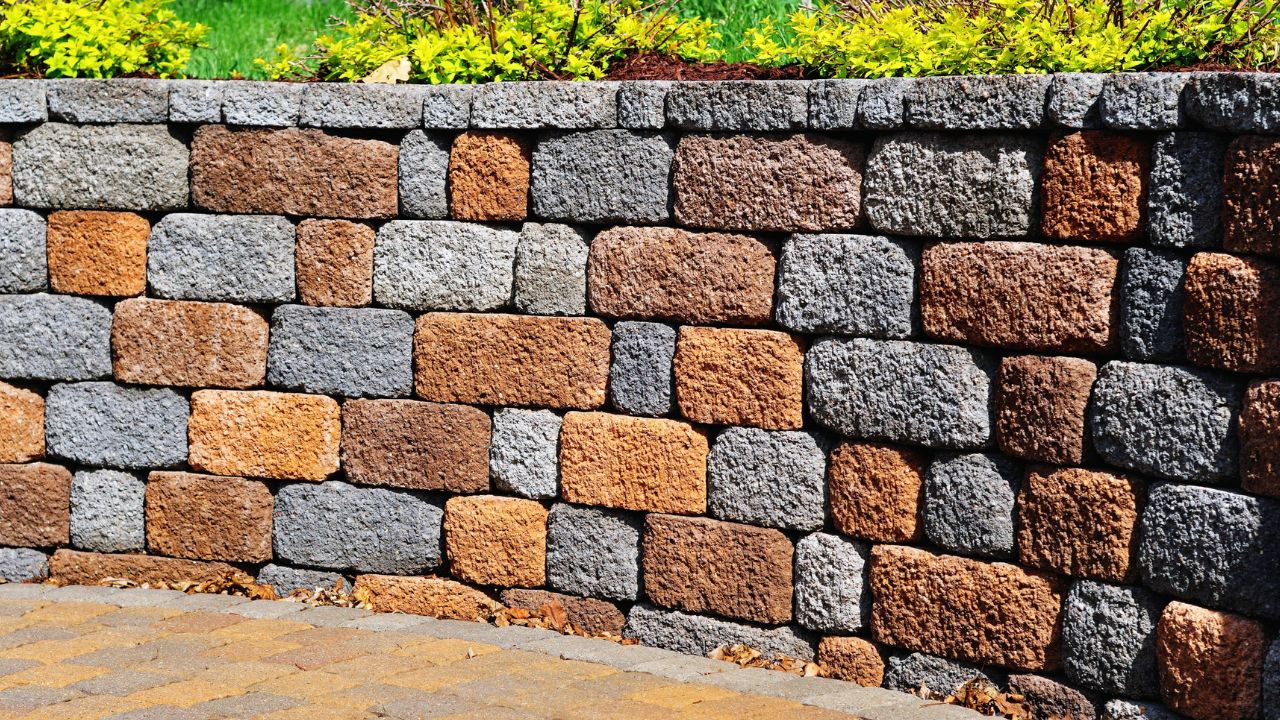
Concrete Retaining Wall Ideas
Concrete retaining walls are one type of retaining wall that is quite popular. Because of the material’s properties, these walls are specifically proficient in keeping soil in place and reducing the chances of sinkholes and flooding. Some common types of concrete resting walls are:
Smooth and Modern Designs
The smooth and modern design of concrete retaining walls gives off a high-end look without spending a lot on its cost because concrete can be inexpensive. They are an added element that gives an elegant edge to a modern home.
Stamped and Textured Concrete
Stamped concrete has an imprinted pattern of texture or embossing. This resembles brick, slate, flagstone, tiles, or wood. Textured concrete is less uniform than stamped concrete. This is a great way to add an element of interest to an otherwise plain wall.
Colored Concrete for an Aesthetic Look
These retaining walls can be colored or stained with the tint of your choice. They are great options for people who want to maintain a specific color theme within their home, a theme they can now preserve in the landscaping of their house.
Decorative Concrete Retaining Walls
The decorative style gives off the impression of stone or masonry, perfect for aesthetic purposes and following a theme within the house. These give your resting walls a fairytale look.
Timber Retaining Wall Ideas
Timber retaining walls consist of a specific size of lumber (6″×6″ or 8″×8″) stacked on top of each other. The bottom part of the timber is secured with driving steel rebar running through the timber structure and into the ground. The timber is tied in with long skews, spikes, or nails. Timber walls can be:
Natural and Rustic Designs
Natural and rustic timber wall design means that leftover wood from used timber is reclaimed and reused. The look not only gives a natural and raw vibe, but it is also environmentally friendly.
Railroad Tie Retaining Walls
Railroad tie or wood tie retaining walls is a fascinating style of retaining walls. It is made up of wood ties that are tied together and placed in a way that they act as retaining walls. Some people find these a practical option, and they are very cheap to install as well.
Treated Pine Retaining Walls
These timber retaining walls are commonly used for outdoor installation, such as building garden beds and retaining walls. Treated pine is a kind of timber that has been soaked in a chemical that improves its resistance to decay, insects, and other deteriorating factors. This is why it is a good material to use for a retaining wall.
Cedar Retaining Walls for a Classic Look
Cedar is a type of wood that is durable and very versatile. It is commonly referred to as a domestic hardwood because it is easily used within homes. Its natural weather-resistant properties make it a favorable material for constructing resting walls. It is durable but not very resistant to rotting.
Incorporating Timber Steps and Benches
Timber is a heavy-duty material and is good for making similarly heavy-duty structures. It also lasts long and gives off a very clean and chic look. Wooden steps and benches are classic and give your house a modern or classical look.
Stone Retaining Wall Ideas
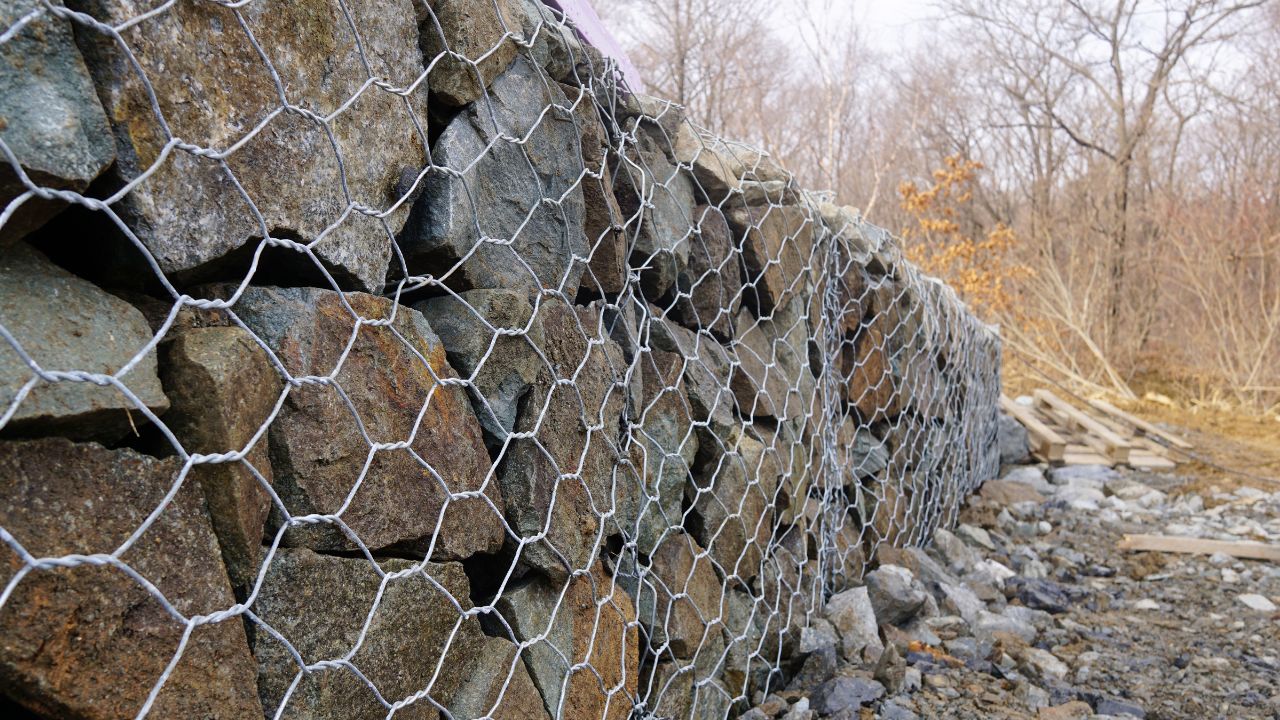
Stone retaining walls are used to improve the functionality of your garden or backyard. They serve a functional and aesthetic purpose. Homeowners use stone retaining walls to control erosion and improve their yards’ aesthetic appeal.
Using Natural Stone for a Timeless Look
Natural stones like limestone and granite are popular choices. Granite gives off a natural reddish hue, and sandstone or limestone gives off an earthy vibe. Marble is also popular for creating a natural and timeless look within your landscape.
Stacked Stone Retaining Walls
This is an old-fashioned style of wall building where walls are constructed by stacking different sizes of stone slabs on top of each other. It is a traditional method that does not require the use of mortar or grout. It is a classic look and is still popular.
Mosaic and Patterned Stone Designs
Mosaics are created by small, colorful pieces of stone put together on a surface. Mosaic and patterned retaining walls create a work of art within the garden walls and are a great way to add a personalized touch to your landscape.
Dry-Stacked Stone Walls
These are similar to the stacked stone retaining walls, where the recommended height for them is three feet on a clay surface. Because they do not absorb water, they are ideal for building retaining walls without the use of reinforcement.
Incorporating Water Features and Fountains
Using stone to add water features and fountains in your backyard is a great way to add character to a simple landscape. It gives off a cottage-core aesthetic that is very popular nowadays.
Brick Retaining Wall Ideas
Brick walls are aesthetic and also functionally appropriate to be used to construct retaining walls. It is a commonly used material for this and gives an overall warm and inviting look, in comparison to stone and concrete, which often look dull and dreary.
Traditional and Timeless Designs
Using traditional red bricks for retaining walls gives a timeless and elegant look because the bricks are naturally weathered. They are cheap, highly effective, and a traditional alternative.
Colored Brick Retaining Walls
This is for those people that want to follow a traditional theme and add a twist to it. Using colored bricks gives a very smart and personalized touch to retaining walls and helps make your landscape more cohesive.
Herringbone and Basket Weave Patterns
These patterns can be achieved in various textile materials, including bricks. A basket weave consists of horizontal and vertical strands of material that appear to be woven together like baskets, while herringbone has a different v-shaped weave.
Incorporating Brick Steps and Planters
If properly installed, brick steps are very durable and can withstand most weather conditions. Steps and planters made of brick last for a long time and are a great addition to the aesthetic of your home.
Gabion Retaining Wall Ideas
This is a training wall made up of stone-filled gabions stacked and tied together with a wire. Walls made up of gabions are usually battered or angled towards the slope rather than stacked vertically.
The Stylish and Sustainable Solution
Gabion retaining walls are very popular because they are stylish and sustainable at the same time. Their slight tilt is a great feature that adds interest to your backyard.
Using Gabion Baskets for a Modern Look
Gabion baskets are hexagonal mesh made up of heavily galvanized steel wire. The baskets are filled with rocks and stacked on each other, giving off a modern look.
Combining Gabion and Stone for a Rustic Effect
The interesting combination of stone and gabion gives a very rustic and raw look. It is also helpful if you need to cover up old or damaged siding. Both materials do the job very well while maintaining a natural look.
Incorporating Plants and Flowers into Gabion Walls
Since they are put together as little pockets or baskets, it is very easy to incorporate flowers or plants within them. This is perfect for improving the environment and cutting through the gray color with greenery. It is a very sustainable and sleek option.
Block Retaining Wall Ideas
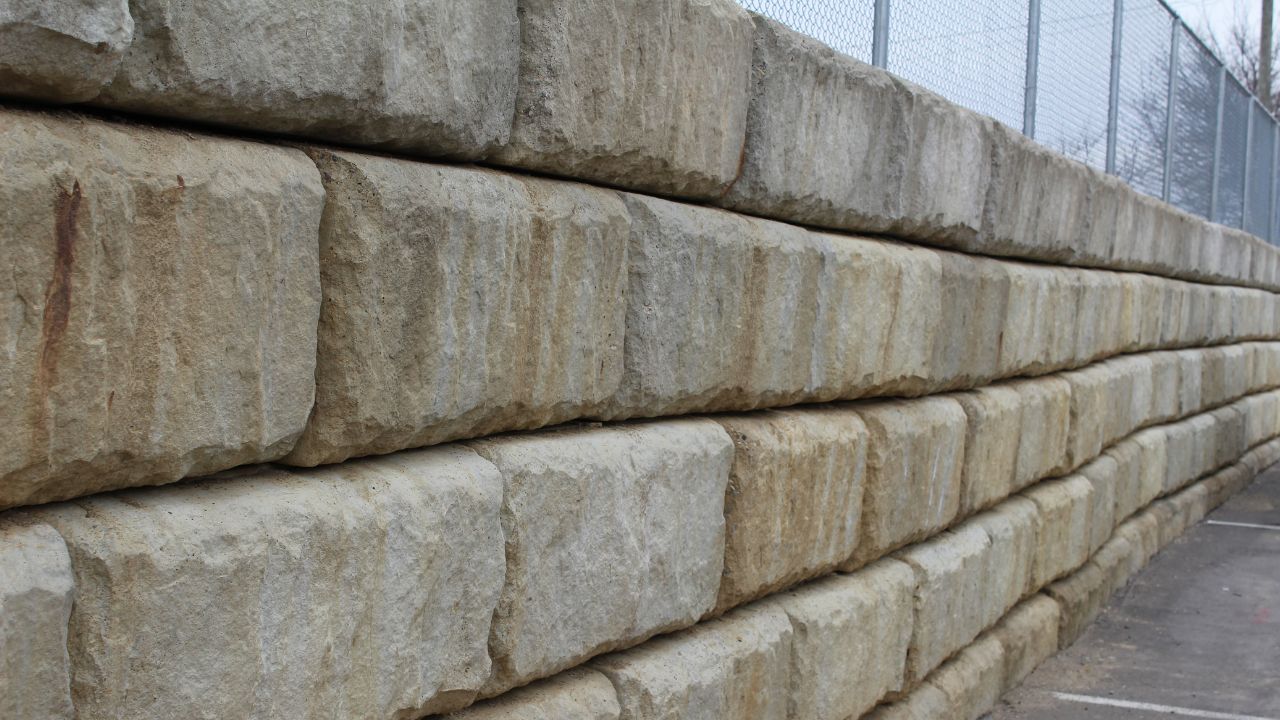
A block wall, also known as a masonry wall comprises large blocks of different materials such as wonder or concrete. Because of the bulky and robust material, they make great retaining walls.
Simple and Affordable Solutions
Cinder block walls are a very cheap and affordable choice for retaining walls. They give a simple and clean look to any landscape.
Using Colored Blocks for a Unique Look
Colored concrete blocks allow the buyer to give a touch of personalization to the otherwise plain blocks. You can choose the color of your choice to match the theme of your house.
Combining Different Block Sizes and Shapes
Other than using different colors for personalization, you can even use blocks of different shapes and sizes to give a more unique look. This will help add a creative touch to your work.
Incorporating Built-In Seating and Fire Pits
Because the blocks have a simple structure, it is easy to manipulate them. It is easy to cut the blocks to add seating and firing pits.
Boulder Retaining Wall Ideas
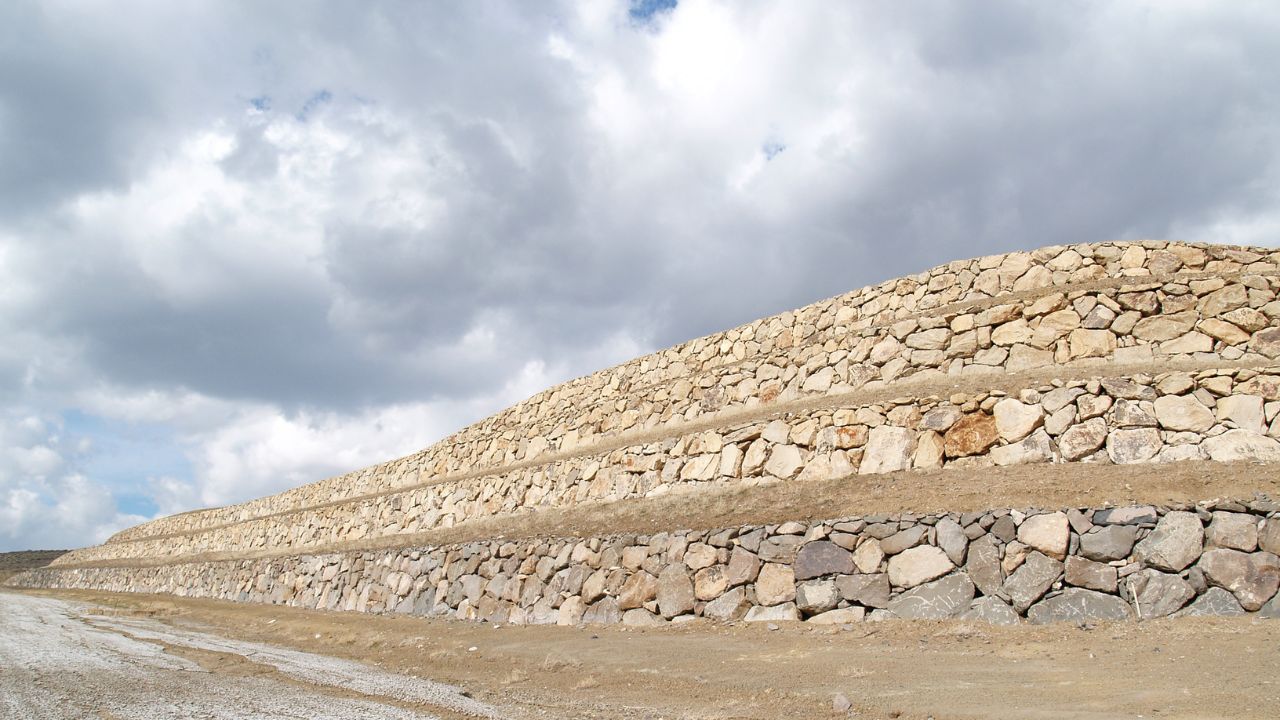
Boulders are also a great material to build retaining walls from. They are sturdy and make up for natural retaining walls.
Using Natural Boulders for a Rustic Look
Since boulders are a natural material, they give off a rustic and natural vibe.
Combining Boulders with Stone and Concrete
To give a more varied look than just plain boulders, combining stone and concrete with it nails the look. It also makes the wall firm and sturdy.
Creating Terraced Boulders for Maximum Impact
Terraced builder retaining walls are not only aesthetically pleasing, but from a technical aspect, they provide longevity to a landscape.
Incorporating Lighting for Nighttime Ambiance
Boulders can be cut into to make space for the installation of lights and light fixtures. This provides a beautiful look and creates the perfect nighttime ambiance for events and gatherings.
Sheet Pile Retaining Wall Ideas
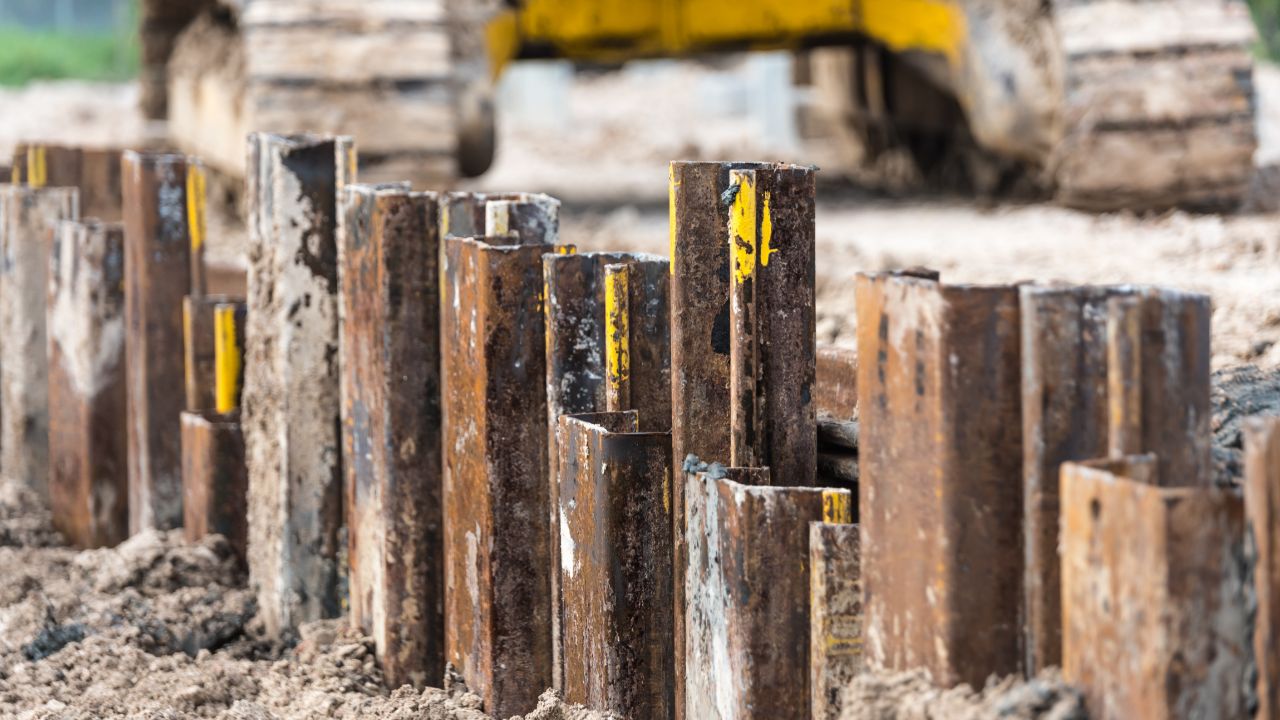
Sheer piles are made of steel and serve the same purpose as any other retaining wall. However, they’re generally used for waterfront structures such as shares, piers, and quays.
Strong and Efficient Solution
They are strong and also very efficient. They can be used for permanent as well as temporary structures.
Using Steel Sheet Piles for Durability
Sheet Piles can withstand all kinds of weather and are said to last a long if maintained properly. The use of steel to create retaining walls is naturally going to give a sleek and modern-tech look.
Retaining Wall Planters and Garden Beds
Reading walls can become a structure to support planters and garden beds if placed strategically. Below are a few ideas of how it can be done:
Creating Vertical Gardens with Retaining Walls
Little alcoves and pockets can be created in the walls depending on the type of material used. The space can then be used to place specific plants in them.
Incorporating Planter Boxes into Retaining Walls
Retaining wall planters and garden beds surround the entire house, creating a protected environment for your plants. Garden beds can be planted alongside retaining walls. Though, it is important to select the appropriate kind of plant. Perennials and shrubs are the most appropriate choice for this. A raised garden bed is when the soil for the plants is raised above the ground. If retaining walls are made up of any nom-decay material, they can be used to form raised garden beds.
Retaining Wall Fencing Ideas
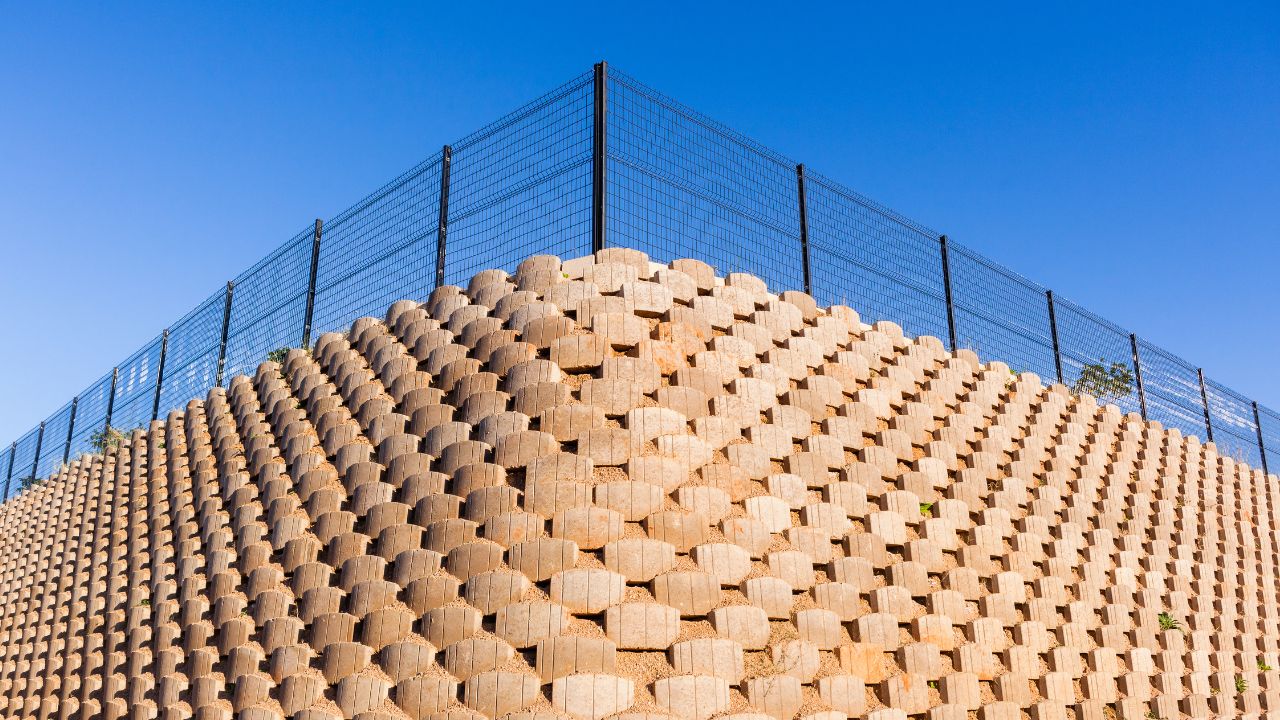
Fencing with retaining walls helps retain the difference in ground level. The retaining wall can serve as the base of a fence.
Creating Privacy with Retaining Wall Fencing
A retaining wall; strategically built a few feet away from an existing fence can be a great way to add privacy to your landscape without putting too much energy and resources into it.
Using Fencing Materials in Retaining Walls
If you want to include fencing materials to retaining walls, then the most suitable combination would be to use surface-mounted fences with retaining walls that have already been poured.
Creating Fencing with Stacked Stone Walls
Using stacked stone to build fences will create a fence that will be thicker than normal. It is a traditional method of creating boundaries in fields.
Incorporating Climbing Plants for a Green Wall Effect
Green walls are vertical structures that have plants attached to them. They work to regulate pollution levels in the air. Attaching climbing plants to green walls increases maintenance efforts, but they are captivating.
Retaining Wall Water Feature Ideas
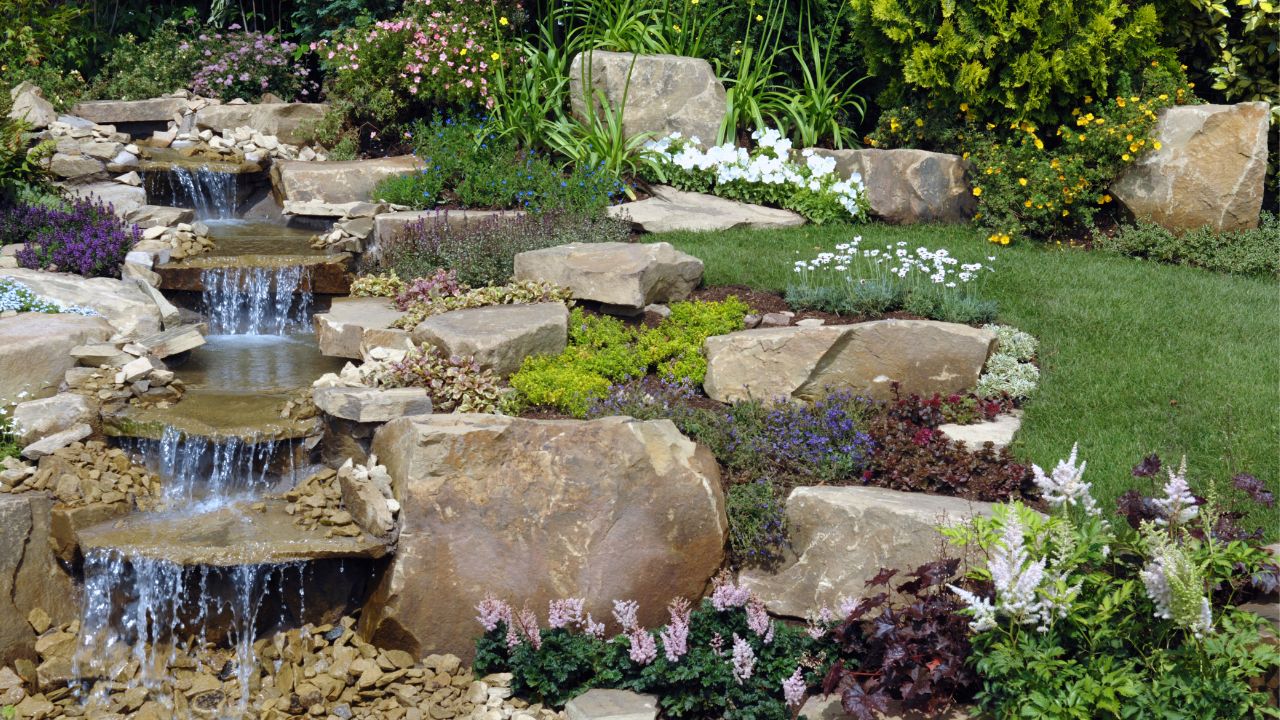
If you do not want your retaining walls to look bland, there is always an option.
Creating Waterfalls with Retaining Walls
Waterfall features within the retaining walls will complete the fairytale look of your backyard. The waterfall is built in a way that the basin and the pump are hidden within the wall, and only the water spilling out is visible.
Read More: Structural Engineer in Central Coast
Incorporating Fountains into Retaining Walls
It is a popular way to incorporate a water feature in retaining walls. Wall fountains are electric components that can be easily fitted into a wall. They then spray water, like a fountain, onto a flat surface.
There is a lot of variety when it comes to retaining walls. Once you step into this rabbit hole, you may need help with the sheer amount of types and styles, costs, and personalization options. The best way to get around this is to do some research, and the above article will hopefully provide comprehensive information to all you need to know.

